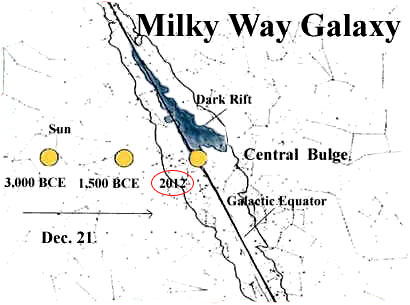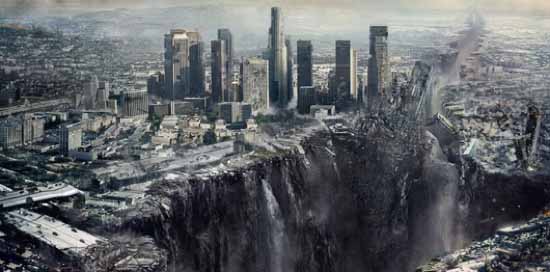|
THE HOW AND WHY OF THE
MAYAN END DATE IN 2012 A.D
Why did the ancient Mayan
or pre-Maya choose December 21st, 2012 A.D., as the end of their Long Count
calendar? This article will cover some recent research. Scholars have known
for decades that the 13-baktun cycle of the Mayan "Long Count" system of
timekeeping was set to end precisely on a winter solstice, and that this
system was put in place some 2300 years ago. This amazing fact - that ancient
Mesoameri- can skywatchers were able to pinpoint a winter solstice far
off into the future - has not been dealt with by Mayanists. And why did
they choose the year 2012? One immediately gets the impression that there
is a very strange mystery to be confronted here. I will be building upon
a clue to this mystery reported by epigrapher Linda Schele in Maya Cosmos
(1994). This article is the natural culmination of the research relating
to the Mayan Long Count and the precession of the equinoxes that I explored
in my recent book Tzolkin: Visionary Perspectives and Calendar Studies
(Borderlands Science and Research Foundation, 1994).
 |
The Sacred Tree
We are still trying to
answer these questions: What is so important about the winter solstice
of 2012 and, exactly how were calculations made so accurately, considering
that precession should make them exceedingly difficult?
If we make a standard
horoscope chart for December 21st, 2012 A.D., nothing very unusual appears.
In this way I was led astray in my search until Linda Schele provided a
clue in the recent book Maya Cosmos. Probably the most exciting breakthrough
in this book is her identification of the astronomical meaning of the Mayan
Sacred Tree. Drawing from an impressive amount of iconographic evidence,
and generously sharing the process by which she arrived at her discovery,
the Sacred Tree is found to be none other than the crossing point of the
ecliptic with the band of the Milky Way. Indeed, the Milky Way seems to
have played an important role in Mayan imagery. For example, an incised
bone from 8th century Tikal depicts a long sinking canoe containing various
deities. |
| This is a picture of
the night sky and the canoe is the Milky Way, sinking below the horizon
as the night progresses, and carrying with it deities representing the
nearby constellations.
The incredible Mayan site
of Palenque is filled with Sacred Tree motifs and references to astronomical
events. In their book Forest of Kings, Schele and Freidel suggested that
the Sacred Tree referred to the ecliptic.
Apparently that was only
part of the picture, for the Sacred Tree that Pacal ascends in death is
more than just the ecliptic, it is the sacred doorway to the underworld.
The crossing point of Milky Way and ecliptic is this doorway and represents
the sacred source and origin. In the following diagram of the well known
sarcophagus carving, notice that the Milky Way tree serves as an extension
of Pacal's umbilicus. The umbilicus is a human being's entrance into life,
and entrance into death as well:
We may also remember at
this point that the tzolkin calendar is said to spring from the Sacred
Tree. The Sacred Tree is, in fact, at the center of the entire corpus of
Mayan Creation Myths. We should definitely explore the nature of this astronomical
feature.
 The first question that came
up for me was as follows. Since Lord (Ahau) Pacal is, by way of divine
kingship, equated with the sun, and he is portrayed "entering" the Sacred
Tree on his famous sarcophagus lid, on what day does the sun come around
to conjunct the crossing point of ecliptic and Milky Way? This would be
an important date. In the pre-dawn skies of this date, the Milky Way would
be seen to arch overhead from the region of Polaris (Heart of Sky) and
would point right at where the sun rises. This (and the corollary date
6 months later) is the only date when the Sun/Lord could jump from the
ecliptic track and travel the Milky Way up and around the vault of heaven
to the region of Polaris, there to enter the "Heart of Sky." It should
be mentioned that 1300 years ago, during the zenith of Palenque's glory,
Polaris was much less an exact "Pole Star" than it is now. Schele demonstrates
that it wasn't a Pole Star that the Maya mythologized in this regard, it
was the unmarked polar "dark region" symbolizing death and the underworld
around which everything was observed to revolve. Life revolves around death
- a characteristically Mayan belief. The dates on which the sun conjuncts
the "Sacred Tree" are thus very important. These dates will change with
precession. Schele doesn't pursue this line of reasoning, however, and
doesn't even mention that these dates might be significant. If we go back
to 755 A.D., we find that the sun conjuncts the Sacred Tree on December
3rd. I should point out here that the Milky Way is a wide band, and perhaps
a 10-day range of dates should be considered.
The first question that came
up for me was as follows. Since Lord (Ahau) Pacal is, by way of divine
kingship, equated with the sun, and he is portrayed "entering" the Sacred
Tree on his famous sarcophagus lid, on what day does the sun come around
to conjunct the crossing point of ecliptic and Milky Way? This would be
an important date. In the pre-dawn skies of this date, the Milky Way would
be seen to arch overhead from the region of Polaris (Heart of Sky) and
would point right at where the sun rises. This (and the corollary date
6 months later) is the only date when the Sun/Lord could jump from the
ecliptic track and travel the Milky Way up and around the vault of heaven
to the region of Polaris, there to enter the "Heart of Sky." It should
be mentioned that 1300 years ago, during the zenith of Palenque's glory,
Polaris was much less an exact "Pole Star" than it is now. Schele demonstrates
that it wasn't a Pole Star that the Maya mythologized in this regard, it
was the unmarked polar "dark region" symbolizing death and the underworld
around which everything was observed to revolve. Life revolves around death
- a characteristically Mayan belief. The dates on which the sun conjuncts
the "Sacred Tree" are thus very important. These dates will change with
precession. Schele doesn't pursue this line of reasoning, however, and
doesn't even mention that these dates might be significant. If we go back
to 755 A.D., we find that the sun conjuncts the Sacred Tree on December
3rd. I should point out here that the Milky Way is a wide band, and perhaps
a 10-day range of dates should be considered. |
|
To start with, however, I
use the exact center of the Milky Way band that one finds on star charts,
known as the "Galactic Equator" (not to be confused with Galactic Center).
Where the Galactic Equator crosses the ecliptic in Sagittarius just happens
to be where the dark rift in the Milky Way begins. This is a dark bifurcation
in the Milky Way caused by interstellar dust clouds. To observers on earth,
it appears as a dark road which begins near the ecliptic and stretches
along the Milky Way up towards Polaris. The Maya today are quite aware
of this feature; the Quich» Maya call it xibalba be (the "road to
Xibalba") and the Chorti Maya call it the "camino de Santiago". In Dennis
Tedlock's translation of the Popol Vuh, we find that the ancient Maya called
it the "Black Road". The Hero Twins Hunahpu and Xbalanque must journey
down this road to battle the Lords of Xibalba. (Tedlock 334, 358). Furthermore,
what Schele has identified as the Sacred Tree was known to the ancient
Quich» simply as "Crossroads."
This celestial feature
was not marginal in ancient Mayan thought and is still rec- ognized even
today. In terms of how this feature was mythologized, it seems that when
a planet, the sun, or the moon entered the dark cleft of the Milky Way
in Sagittarius (which happens to be the exact center of the Milky Way,
the Galactic Equator), entrance to the underworld road was possible, which
could then take the journeyer up to the Heart of Sky. Shamanic vision rites
were probably involved in this scenario. In the Yucatan, underground caves
were ritual places used by shaman to journey to the underworld. Schele
explains that "Mayan mythology identifies the Road to Xibalba as going
through a cave" (Forest of Kings, 209). Here we have a metaphorical reference
to the "dark rift" in the Milky Way by way of its terrestrial counterpart,
a syncretism between earth and sky which is characteristic of Mayan thinking.
Above all, what is becoming apparent from the corpus of Mayan Creation
Myths is that creation seems to have taken place at a celestial crossroads
- the crossing point of ecliptic and Milky Way.
To clarify this ever growing
picture, we should stop here and plot out some charts. In addition to the
detailed star maps from Norton's 2000.0 Star Atlas which allowed me to
pinpoint the crossing point of Galactic Equator and ecliptic, I use EZCosmos
to plot these positions3. What I found answers the question of why the
Maya chose the winter solstice of 2012, a problem seemingly avoided by
astronomers and Mayanists alike. While it is true that the sun conjuncts
the Sacred Tree on December 3rd in the year 755 A.D., over the centuries
precession has caused the conjunction date to approach the winter solstice.
So, how close are we to perfect conjunction today? Exactly when might we
expect the winter solstice sun to conjunct the crossing point of Galactic
Equator and ecliptic - the Mayan Sacred Tree? Any astronomer will tell
you that, presently, the Milky Way crosses the ecliptic through the constellation
of Sagittarius and this area is rich in nebulae and high density objects.
In
fact, where the Milky Way crosses the ecliptic in Sagittarius also happens
to be the direction of the Galactic Center.4
So the quest returns to
identifying why December 21st, 2012 A.D. might represent some kind of astronomical
anomoly. I'll get right to the heart of the matter. Let's look at a few
charts. |







